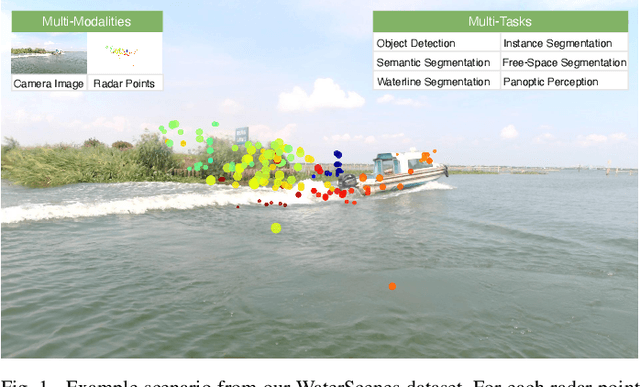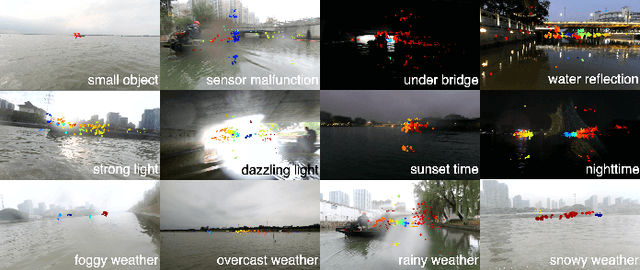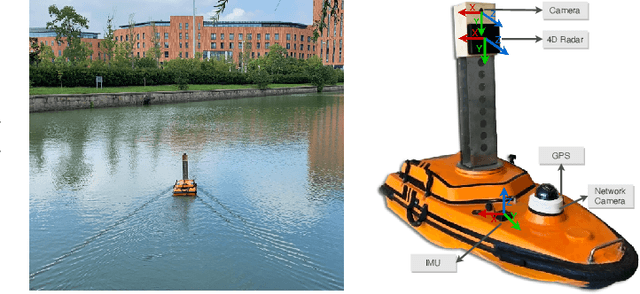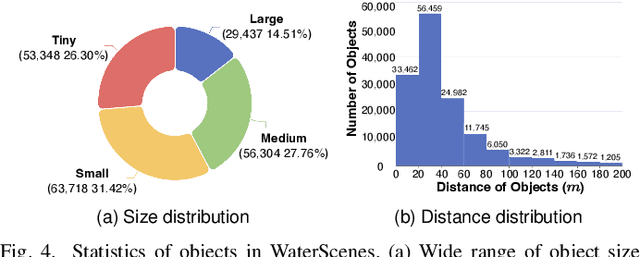Yong Yue
Supervised Visual Docking Network for Unmanned Surface Vehicles Using Auto-labeling in Real-world Water Environments
Mar 05, 2025Abstract:Unmanned Surface Vehicles (USVs) are increasingly applied to water operations such as environmental monitoring and river-map modeling. It faces a significant challenge in achieving precise autonomous docking at ports or stations, still relying on remote human control or external positioning systems for accuracy and safety which limits the full potential of human-out-of-loop deployment for USVs.This paper introduces a novel supervised learning pipeline with the auto-labeling technique for USVs autonomous visual docking. Firstly, we designed an auto-labeling data collection pipeline that appends relative pose and image pair to the dataset. This step does not require conventional manual labeling for supervised learning. Secondly, the Neural Dock Pose Estimator (NDPE) is proposed to achieve relative dock pose prediction without the need for hand-crafted feature engineering, camera calibration, and peripheral markers. Moreover, The NDPE can accurately predict the relative dock pose in real-world water environments, facilitating the implementation of Position-Based Visual Servo (PBVS) and low-level motion controllers for efficient and autonomous docking.Experiments show that the NDPE is robust to the disturbance of the distance and the USV velocity. The effectiveness of our proposed solution is tested and validated in real-world water environments, reflecting its capability to handle real-world autonomous docking tasks.
ULSR-GS: Ultra Large-scale Surface Reconstruction Gaussian Splatting with Multi-View Geometric Consistency
Dec 02, 2024



Abstract:While Gaussian Splatting (GS) demonstrates efficient and high-quality scene rendering and small area surface extraction ability, it falls short in handling large-scale aerial image surface extraction tasks. To overcome this, we present ULSR-GS, a framework dedicated to high-fidelity surface extraction in ultra-large-scale scenes, addressing the limitations of existing GS-based mesh extraction methods. Specifically, we propose a point-to-photo partitioning approach combined with a multi-view optimal view matching principle to select the best training images for each sub-region. Additionally, during training, ULSR-GS employs a densification strategy based on multi-view geometric consistency to enhance surface extraction details. Experimental results demonstrate that ULSR-GS outperforms other state-of-the-art GS-based works on large-scale aerial photogrammetry benchmark datasets, significantly improving surface extraction accuracy in complex urban environments. Project page: https://ulsrgs.github.io.
VMGNet: A Low Computational Complexity Robotic Grasping Network Based on VMamba with Multi-Scale Feature Fusion
Nov 19, 2024



Abstract:While deep learning-based robotic grasping technology has demonstrated strong adaptability, its computational complexity has also significantly increased, making it unsuitable for scenarios with high real-time requirements. Therefore, we propose a low computational complexity and high accuracy model named VMGNet for robotic grasping. For the first time, we introduce the Visual State Space into the robotic grasping field to achieve linear computational complexity, thereby greatly reducing the model's computational cost. Meanwhile, to improve the accuracy of the model, we propose an efficient and lightweight multi-scale feature fusion module, named Fusion Bridge Module, to extract and fuse information at different scales. We also present a new loss function calculation method to enhance the importance differences between subtasks, improving the model's fitting ability. Experiments show that VMGNet has only 8.7G Floating Point Operations and an inference time of 8.1 ms on our devices. VMGNet also achieved state-of-the-art performance on the Cornell and Jacquard public datasets. To validate VMGNet's effectiveness in practical applications, we conducted real grasping experiments in multi-object scenarios, and VMGNet achieved an excellent performance with a 94.4% success rate in real-world grasping tasks. The video for the real-world robotic grasping experiments is available at https://youtu.be/S-QHBtbmLc4.
Unlocking Your Sales Insights: Advanced XGBoost Forecasting Models for Amazon Products
Nov 01, 2024

Abstract:One of the important factors of profitability is the volume of transactions. An accurate prediction of the future transaction volume becomes a pivotal factor in shaping corporate operations and decision-making processes. E-commerce has presented manufacturers with convenient sales channels to, with which the sales can increase dramatically. In this study, we introduce a solution that leverages the XGBoost model to tackle the challenge of predict-ing sales for consumer electronics products on the Amazon platform. Initial-ly, our attempts to solely predict sales volume yielded unsatisfactory results. However, by replacing the sales volume data with sales range values, we achieved satisfactory accuracy with our model. Furthermore, our results in-dicate that XGBoost exhibits superior predictive performance compared to traditional models.
MVG-Splatting: Multi-View Guided Gaussian Splatting with Adaptive Quantile-Based Geometric Consistency Densification
Jul 16, 2024



Abstract:In the rapidly evolving field of 3D reconstruction, 3D Gaussian Splatting (3DGS) and 2D Gaussian Splatting (2DGS) represent significant advancements. Although 2DGS compresses 3D Gaussian primitives into 2D Gaussian surfels to effectively enhance mesh extraction quality, this compression can potentially lead to a decrease in rendering quality. Additionally, unreliable densification processes and the calculation of depth through the accumulation of opacity can compromise the detail of mesh extraction. To address this issue, we introduce MVG-Splatting, a solution guided by Multi-View considerations. Specifically, we integrate an optimized method for calculating normals, which, combined with image gradients, helps rectify inconsistencies in the original depth computations. Additionally, utilizing projection strategies akin to those in Multi-View Stereo (MVS), we propose an adaptive quantile-based method that dynamically determines the level of additional densification guided by depth maps, from coarse to fine detail. Experimental evidence demonstrates that our method not only resolves the issues of rendering quality degradation caused by depth discrepancies but also facilitates direct mesh extraction from dense Gaussian point clouds using the Marching Cubes algorithm. This approach significantly enhances the overall fidelity and accuracy of the 3D reconstruction process, ensuring that both the geometric details and visual quality.
Achelous++: Power-Oriented Water-Surface Panoptic Perception Framework on Edge Devices based on Vision-Radar Fusion and Pruning of Heterogeneous Modalities
Dec 14, 2023



Abstract:Urban water-surface robust perception serves as the foundation for intelligent monitoring of aquatic environments and the autonomous navigation and operation of unmanned vessels, especially in the context of waterway safety. It is worth noting that current multi-sensor fusion and multi-task learning models consume substantial power and heavily rely on high-power GPUs for inference. This contributes to increased carbon emissions, a concern that runs counter to the prevailing emphasis on environmental preservation and the pursuit of sustainable, low-carbon urban environments. In light of these concerns, this paper concentrates on low-power, lightweight, multi-task panoptic perception through the fusion of visual and 4D radar data, which is seen as a promising low-cost perception method. We propose a framework named Achelous++ that facilitates the development and comprehensive evaluation of multi-task water-surface panoptic perception models. Achelous++ can simultaneously execute five perception tasks with high speed and low power consumption, including object detection, object semantic segmentation, drivable-area segmentation, waterline segmentation, and radar point cloud semantic segmentation. Furthermore, to meet the demand for developers to customize models for real-time inference on low-performance devices, a novel multi-modal pruning strategy known as Heterogeneous-Aware SynFlow (HA-SynFlow) is proposed. Besides, Achelous++ also supports random pruning at initialization with different layer-wise sparsity, such as Uniform and Erdos-Renyi-Kernel (ERK). Overall, our Achelous++ framework achieves state-of-the-art performance on the WaterScenes benchmark, excelling in both accuracy and power efficiency compared to other single-task and multi-task models. We release and maintain the code at https://github.com/GuanRunwei/Achelous.
Radar Perception in Autonomous Driving: Exploring Different Data Representations
Dec 08, 2023



Abstract:With the rapid advancements of sensor technology and deep learning, autonomous driving systems are providing safe and efficient access to intelligent vehicles as well as intelligent transportation. Among these equipped sensors, the radar sensor plays a crucial role in providing robust perception information in diverse environmental conditions. This review focuses on exploring different radar data representations utilized in autonomous driving systems. Firstly, we introduce the capabilities and limitations of the radar sensor by examining the working principles of radar perception and signal processing of radar measurements. Then, we delve into the generation process of five radar representations, including the ADC signal, radar tensor, point cloud, grid map, and micro-Doppler signature. For each radar representation, we examine the related datasets, methods, advantages and limitations. Furthermore, we discuss the challenges faced in these data representations and propose potential research directions. Above all, this comprehensive review offers an in-depth insight into how these representations enhance autonomous system capabilities, providing guidance for radar perception researchers. To facilitate retrieval and comparison of different data representations, datasets and methods, we provide an interactive website at https://radar-camera-fusion.github.io/radar.
Efficient-VRNet: An Exquisite Fusion Network for Riverway Panoptic Perception based on Asymmetric Fair Fusion of Vision and 4D mmWave Radar
Aug 20, 2023



Abstract:Panoptic perception is essential to unmanned surface vehicles (USVs) for autonomous navigation. The current panoptic perception scheme is mainly based on vision only, that is, object detection and semantic segmentation are performed simultaneously based on camera sensors. Nevertheless, the fusion of camera and radar sensors is regarded as a promising method which could substitute pure vision methods, but almost all works focus on object detection only. Therefore, how to maximize and subtly fuse the features of vision and radar to improve both detection and segmentation is a challenge. In this paper, we focus on riverway panoptic perception based on USVs, which is a considerably unexplored field compared with road panoptic perception. We propose Efficient-VRNet, a model based on Contextual Clustering (CoC) and the asymmetric fusion of vision and 4D mmWave radar, which treats both vision and radar modalities fairly. Efficient-VRNet can simultaneously perform detection and segmentation of riverway objects and drivable area segmentation. Furthermore, we adopt an uncertainty-based panoptic perception training strategy to train Efficient-VRNet. In the experiments, our Efficient-VRNet achieves better performances on our collected dataset than other uni-modal models, especially in adverse weather and environment with poor lighting conditions. Our code and models are available at \url{https://github.com/GuanRunwei/Efficient-VRNet}.
Achelous: A Fast Unified Water-surface Panoptic Perception Framework based on Fusion of Monocular Camera and 4D mmWave Radar
Jul 14, 2023Abstract:Current perception models for different tasks usually exist in modular forms on Unmanned Surface Vehicles (USVs), which infer extremely slowly in parallel on edge devices, causing the asynchrony between perception results and USV position, and leading to error decisions of autonomous navigation. Compared with Unmanned Ground Vehicles (UGVs), the robust perception of USVs develops relatively slowly. Moreover, most current multi-task perception models are huge in parameters, slow in inference and not scalable. Oriented on this, we propose Achelous, a low-cost and fast unified panoptic perception framework for water-surface perception based on the fusion of a monocular camera and 4D mmWave radar. Achelous can simultaneously perform five tasks, detection and segmentation of visual targets, drivable-area segmentation, waterline segmentation and radar point cloud segmentation. Besides, models in Achelous family, with less than around 5 million parameters, achieve about 18 FPS on an NVIDIA Jetson AGX Xavier, 11 FPS faster than HybridNets, and exceed YOLOX-Tiny and Segformer-B0 on our collected dataset about 5 mAP$_{\text{50-95}}$ and 0.7 mIoU, especially under situations of adverse weather, dark environments and camera failure. To our knowledge, Achelous is the first comprehensive panoptic perception framework combining vision-level and point-cloud-level tasks for water-surface perception. To promote the development of the intelligent transportation community, we release our codes in \url{https://github.com/GuanRunwei/Achelous}.
WaterScenes: A Multi-Task 4D Radar-Camera Fusion Dataset and Benchmark for Autonomous Driving on Water Surfaces
Jul 13, 2023



Abstract:Autonomous driving on water surfaces plays an essential role in executing hazardous and time-consuming missions, such as maritime surveillance, survivors rescue, environmental monitoring, hydrography mapping and waste cleaning. This work presents WaterScenes, the first multi-task 4D radar-camera fusion dataset for autonomous driving on water surfaces. Equipped with a 4D radar and a monocular camera, our Unmanned Surface Vehicle (USV) proffers all-weather solutions for discerning object-related information, including color, shape, texture, range, velocity, azimuth, and elevation. Focusing on typical static and dynamic objects on water surfaces, we label the camera images and radar point clouds at pixel-level and point-level, respectively. In addition to basic perception tasks, such as object detection, instance segmentation and semantic segmentation, we also provide annotations for free-space segmentation and waterline segmentation. Leveraging the multi-task and multi-modal data, we conduct numerous experiments on the single modality of radar and camera, as well as the fused modalities. Results demonstrate that 4D radar-camera fusion can considerably enhance the robustness of perception on water surfaces, especially in adverse lighting and weather conditions. WaterScenes dataset is public on https://waterscenes.github.io.
 Add to Chrome
Add to Chrome Add to Firefox
Add to Firefox Add to Edge
Add to Edge